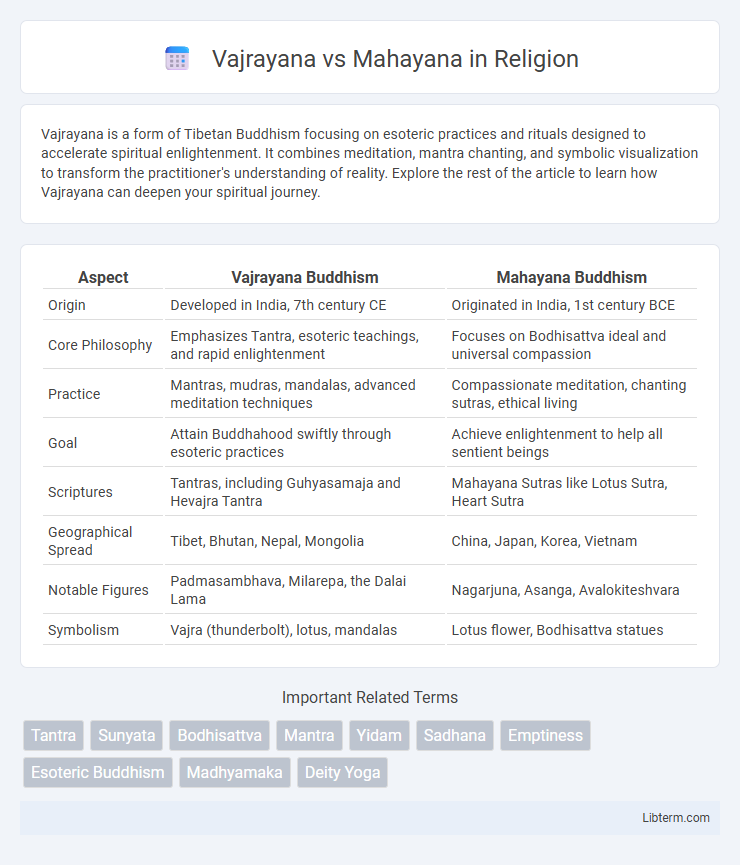Vajrayana is a form of Tibetan Buddhism focusing on esoteric practices and rituals designed to accelerate spiritual enlightenment. It combines meditation, mantra chanting, and symbolic visualization to transform the practitioner's understanding of reality. Explore the rest of the article to learn how Vajrayana can deepen your spiritual journey.
Table of Comparison
| Aspect | Vajrayana Buddhism | Mahayana Buddhism |
|---|---|---|
| Origin | Developed in India, 7th century CE | Originated in India, 1st century BCE |
| Core Philosophy | Emphasizes Tantra, esoteric teachings, and rapid enlightenment | Focuses on Bodhisattva ideal and universal compassion |
| Practice | Mantras, mudras, mandalas, advanced meditation techniques | Compassionate meditation, chanting sutras, ethical living |
| Goal | Attain Buddhahood swiftly through esoteric practices | Achieve enlightenment to help all sentient beings |
| Scriptures | Tantras, including Guhyasamaja and Hevajra Tantra | Mahayana Sutras like Lotus Sutra, Heart Sutra |
| Geographical Spread | Tibet, Bhutan, Nepal, Mongolia | China, Japan, Korea, Vietnam |
| Notable Figures | Padmasambhava, Milarepa, the Dalai Lama | Nagarjuna, Asanga, Avalokiteshvara |
| Symbolism | Vajra (thunderbolt), lotus, mandalas | Lotus flower, Bodhisattva statues |
Introduction to Vajrayana and Mahayana
Vajrayana and Mahayana are two major branches of Buddhism, each with distinct practices and philosophies. Mahayana emphasizes the path of the Bodhisattva, aiming for enlightenment through compassion and the liberation of all beings, while Vajrayana incorporates esoteric rituals, mantras, and tantric techniques to accelerate the attainment of Buddhahood. Vajrayana, often referred to as Tantric Buddhism, is considered an advanced form of Mahayana that uses symbolic rituals and meditation methods to achieve spiritual transformation more rapidly.
Historical Origins and Development
Vajrayana Buddhism emerged around the 7th century CE as an esoteric extension of Mahayana, incorporating tantric practices and rituals to accelerate enlightenment. Mahayana Buddhism, originating in the 1st century CE, developed from early Buddhist traditions emphasizing the bodhisattva ideal and the pursuit of universal compassion. Vajrayana's historical development is closely tied to regions such as Tibet and Bhutan, where it integrated indigenous Bon elements, distinguishing its ritualistic and philosophical characteristics from mainstream Mahayana schools prevalent in East Asia.
Core Philosophical Differences
Vajrayana emphasizes esoteric teachings, ritual practices, and the use of mantras and mandalas as means to attain enlightenment rapidly, contrasting with Mahayana's broader focus on the Bodhisattva ideal and the pursuit of enlightenment over multiple lifetimes. Core philosophical differences include Vajrayana's reliance on tantra and the belief in transforming ordinary experiences into the path of awakening, while Mahayana centers on the concepts of emptiness (shunyata) and compassion (karuna) as fundamental principles. Vajrayana practitioners engage in guru devotion and intricate meditation techniques aimed at realizing the innate Buddha-nature more directly than the generally more gradual approach found in Mahayana traditions.
Key Practices and Rituals
Vajrayana emphasizes tantric practices, including mantra recitation, deity visualization, and elaborate rituals such as mandala offerings and guru yoga, which aim to accelerate enlightenment through direct experiential methods. Mahayana focuses on the cultivation of bodhicitta, compassion, and the practice of the Six Perfections (paramitas), with meditation and ethical conduct as central elements. Both traditions incorporate ritual elements but Vajrayana's use of esoteric techniques and symbolic implements distinguishes its practice intensity and complexity.
Role of Deities and Iconography
Vajrayana emphasizes elaborate deity yoga and complex iconography, where practitioners visualize themselves as tantric deities embodying enlightened qualities for transformation. Mahayana incorporates bodhisattva figures symbolizing compassion and wisdom but employs simpler iconography focused on teachings and ethical ideals rather than ritual visualization. The rich symbolism in Vajrayana's mandalas and tantric rituals contrasts with Mahayana's more accessible imagery centered on bodhisattvas like Avalokiteshvara and Manjushri.
Views on Enlightenment
Vajrayana Buddhism views enlightenment as an attainable goal within a single lifetime through advanced esoteric practices, utilizing rituals, mantras, and meditation to accelerate spiritual progress. Mahayana Buddhism emphasizes the Bodhisattva path, where enlightenment is pursued over multiple lifetimes to achieve Buddhahood for the benefit of all sentient beings. Both traditions uphold the concept of emptiness (sunyata), but Vajrayana incorporates tantric methods believed to transform the practitioner's body and mind rapidly toward enlightenment.
Lineage and Transmission
Vajrayana lineage emphasizes direct, often secretive transmission of tantric teachings from guru to disciple, ensuring the preservation of esoteric practices within a close master-student relationship. Mahayana lineage is characterized by scriptural study and broader monastic traditions, with teachings passed through established sanghas focused on the bodhisattva path. Transmission in Vajrayana often includes initiation rites and empowerments that embody experiential wisdom, contrasting with Mahayana's emphasis on textual exegesis and community-based ethical training.
Geographical Distribution
Vajrayana Buddhism is primarily practiced in Tibet, Bhutan, and Mongolia, with significant communities in Nepal and parts of Northern India such as Ladakh and Sikkim. Mahayana Buddhism has a broader geographical distribution across East Asia, including China, Japan, Korea, Vietnam, and Taiwan. The spread of Vajrayana stems from Tibetan cultural influence, while Mahayana's expansion is tied to the historical Silk Road and East Asian cultural spheres.
Influence on Art and Culture
Vajrayana Buddhism profoundly shapes Tibetan art with its intricate thangka paintings, mandalas, and ritual objects symbolizing esoteric teachings and meditation practices. Mahayana Buddhism influences East Asian culture through serene Zen gardens, calligraphy, and Buddhist sculpture emphasizing compassion and enlightenment. Both traditions inspire diverse artistic expressions reflecting their unique philosophical and ritualistic elements.
Contemporary Relevance and Adaptation
Vajrayana Buddhism, practiced mainly in Tibet, Bhutan, and parts of Nepal, emphasizes esoteric rituals, tantra, and meditation techniques that adapt to modern spiritual seekers seeking direct experiential insight. Mahayana Buddhism, prominent in East Asia, appeals broadly through its focus on the bodhisattva ideal and compassion, integrating seamlessly with contemporary social activism and psychological well-being movements. Both traditions evolve by incorporating modern technology and global connectivity to spread teachings and foster international communities.
Vajrayana Infographic

 libterm.com
libterm.com